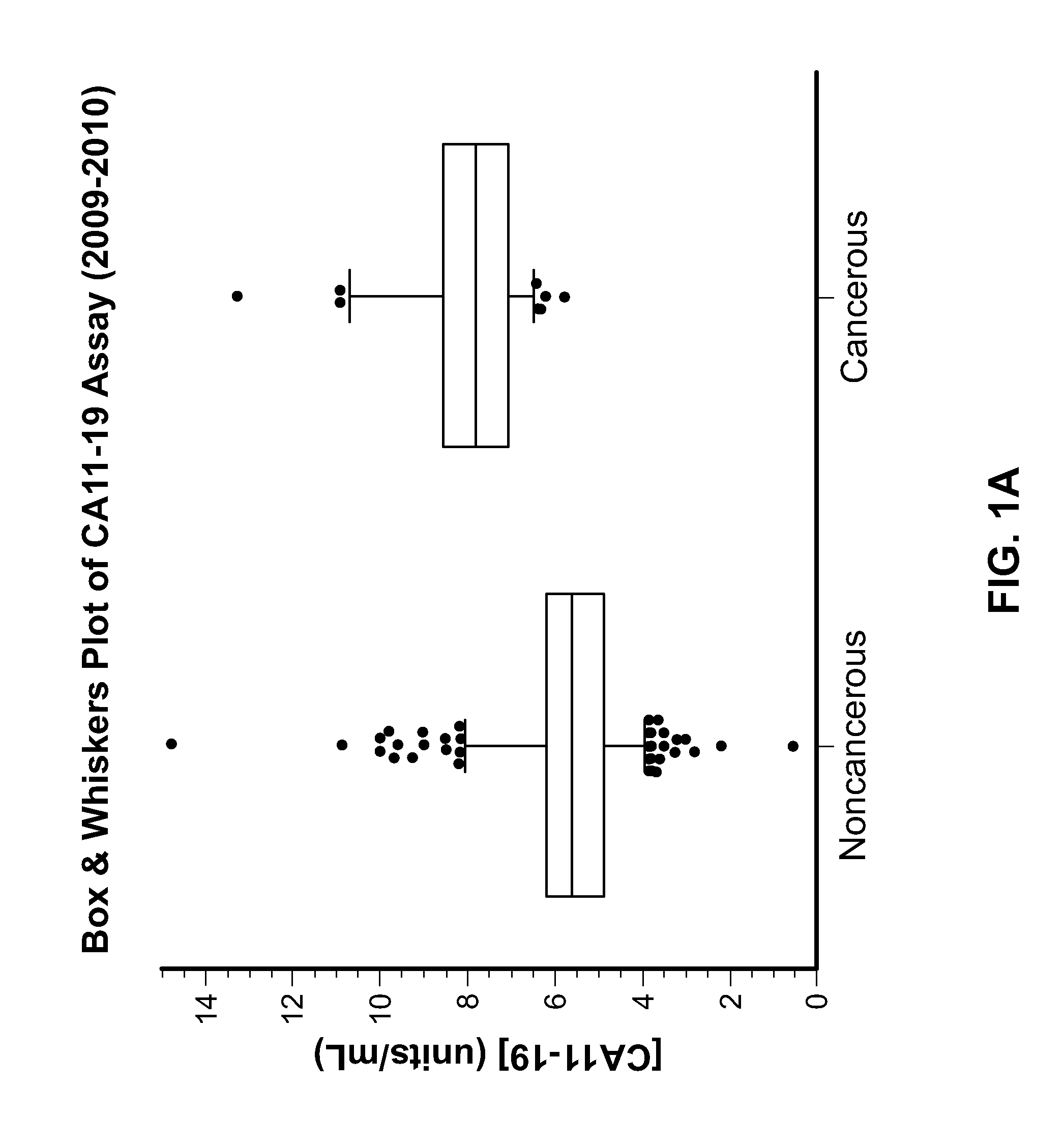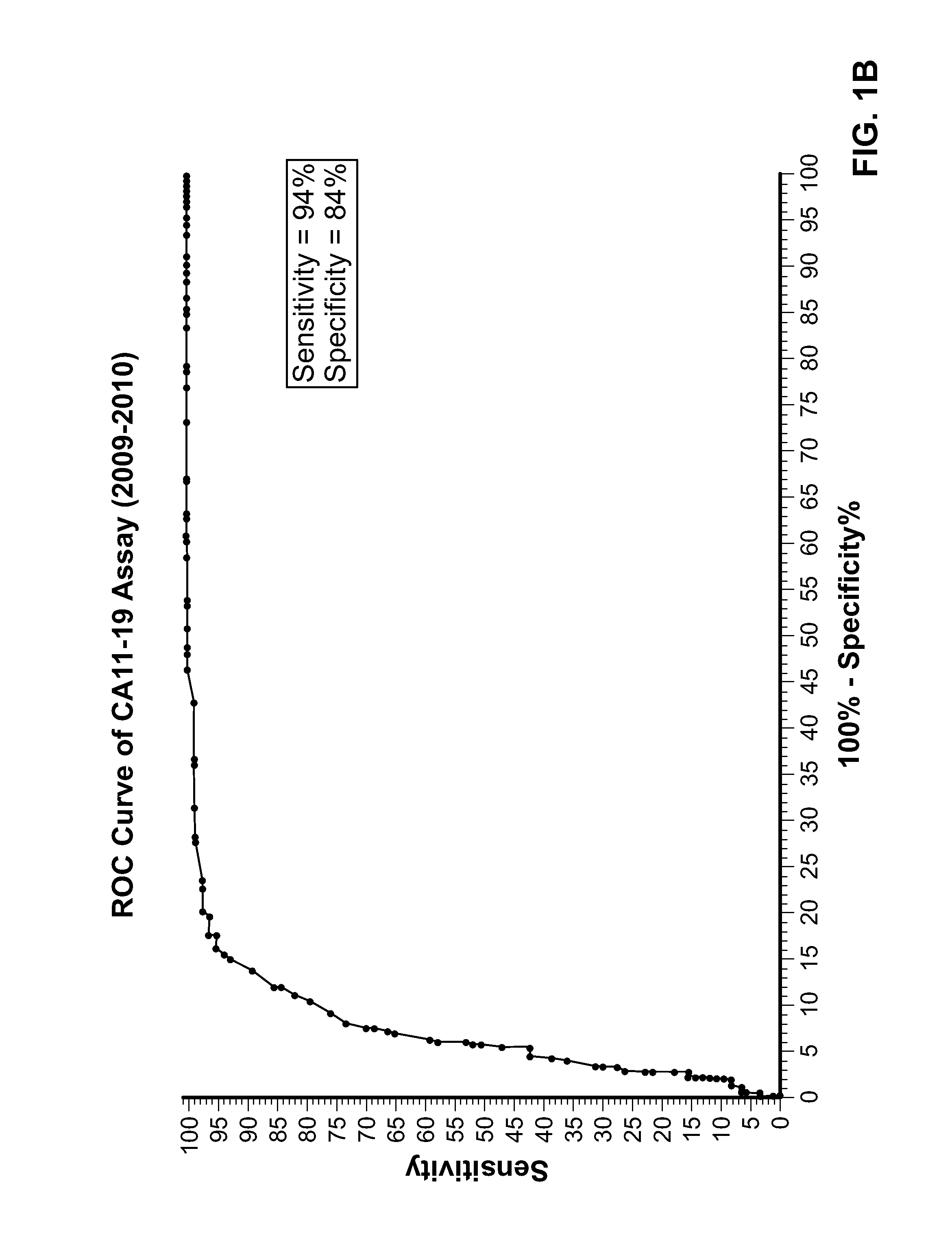Methods and compositions for screening and detecting biomarkers
a biomarker and composition technology, applied in the field of biomarker detection methods and compositions, can solve the problems of insufficient robustness of serological techniques, millions of deaths annually caused by carcinomas, and inability to produce original results for further studies, etc., and achieve the effect of altering the glycosylation pattern
- Summary
- Abstract
- Description
- Claims
- Application Information
AI Technical Summary
Benefits of technology
Problems solved by technology
Method used
Image
Examples
example 1
[0140]A perchloric acid tumor extract prepared from liver and colon cancer tissues was used to prepare polyclonal and monoclonal antibodies. The HAI test referred to as the Tennagen assay was developed solely using a polyclonal antibody and was used to diagnose colon cancer. An ELISA test using two specific monoclonal antibodies as capture antibodies and the polyclonal antibody as a signal generating antibody was developed later. A cocktail of the two specific monoclonal antibodies in the ELISA Assay repeatedly have a sensitivity of 95+% to Early Stage Colorectal carcinoma and a specificity of 94+% when serum samples from patients not known to have this condition are analyzed.
[0141]Immunohistochemical studies have shown the two monoclonal antibodies attach to the cell membranes of adenocarcinoma of colorectal cancer but do not attach to normal tissue. No attachment to cells in bladder or breast tissue is seen.
Materials and Methods
Immunization
[0142]Lots of several Tennessee Antigen (...
example 2
[0164]The identity of the antigen that is being detected by the antibody assays described above has been difficult to determine. The perchloric acid carcinoma cell extract CA11-19 contains a number of different proteins. Further purification of the perchloric acid extract has identified a fraction of about 60-65 kDa and a fraction of about 100 kDa. However, the 60-65 kDa fraction, when used to immunize animals, has not provided any antibodies that specifically detect early stage colorectal carcinoma.
Isolation and Characterization of Antigens Present in the CA11-19 Preparation.
[0165]Human adenocarcinoma tumor tissue from colon and liver were extracted. The purification procedure involved a perchloric acid extraction with further purification steps including Sepharose 4B® and Sephadex G200® chromatography. Following SOP guidelines, SDS gel, Western Blot, immunoelectrophoresis and antigen content / protein determinations were used for all antigen lots. Over 100 different tumor tissues we...
example 3
[0173]Separation of the 100 kDa material and the 60-65 kDa material Separation of high molecular weight material from low molecular weight material in adenocarcinoma tumor cell extracts in preparation for amino acid sequencing of large molecular weight fraction
Materials and Methods
Tumor Cell Material
[0174]Two different tumor cell specimens were obtained from adenocarcinoma from colorectal tissue. One tumor cell specimen is a stage II adenocarcinoma identified as 167B-80. A second tumor cell specimen is also an adenocarcinoma stage II identified as 173-81. Control colorectal and tubular adenoma serum specimens are identified as HF numbers.
Tumor Cell Extraction
[0175]Tumor cell extracts from each tumor cell specimen were prepared by mincing into very small pieces and extracting the material with 1.4% perchloric acid.
[0176]Aqueous Perchloric acid extracts of each tumor cell extract were separated by column chromatography on Sepharose 4B. Fractions were collected and...
PUM
| Property | Measurement | Unit |
|---|---|---|
| concentration | aaaaa | aaaaa |
| molecular weight | aaaaa | aaaaa |
| molecular weight | aaaaa | aaaaa |
Abstract
Description
Claims
Application Information
 Login to View More
Login to View More - R&D
- Intellectual Property
- Life Sciences
- Materials
- Tech Scout
- Unparalleled Data Quality
- Higher Quality Content
- 60% Fewer Hallucinations
Browse by: Latest US Patents, China's latest patents, Technical Efficacy Thesaurus, Application Domain, Technology Topic, Popular Technical Reports.
© 2025 PatSnap. All rights reserved.Legal|Privacy policy|Modern Slavery Act Transparency Statement|Sitemap|About US| Contact US: help@patsnap.com



